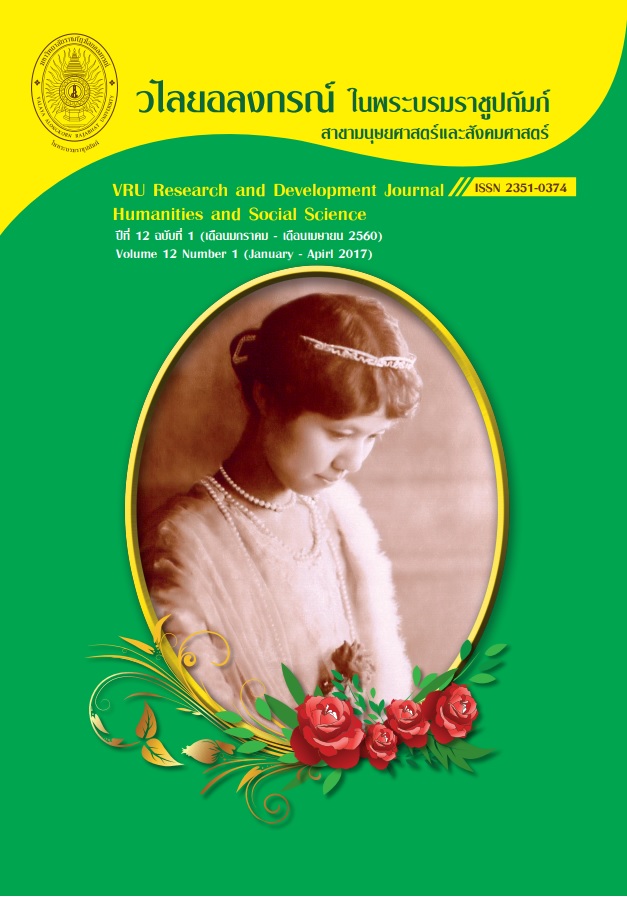การโฆษณาออนไลน์ด้านการท่องเที่ยวเพื่อกลุ่มผู้สูงอายุ
Main Article Content
Abstract
บทความนี้ใช้การศึกษาและวิเคราะห์บนพื้นฐานของแนวคิด ทฤษฎี และหลักฐานวิจัยเชิงประจักษ์เกี่ยวกับการโฆษณาออนไลน์ด้านการท่องเที่ยวเพื่อกลุ่มผู้สูงอายุ โดยมีวัตถุประสงค์ 2 ประการ คือ 1) อธิบายรูปแบบการโฆษณาออนไลน์ด้านการท่องเที่ยวเพื่อกลุ่มผู้สูงอายุ 2) วิเคราะห์ความสำคัญของการโฆษณาออนไลน์กับธุรกิจการท่องเที่ยวเพื่อกลุ่มผู้สูงอายุ ตลอดจนให้ข้อเสนอแนะสำหรับองค์การธุรกิจท่องเที่ยวเพื่อเป็นแนวทางในการสร้างธุรกิจให้ประสบความสำเร็จ เพื่อเป็นข้อมูลให้กับองค์การธุรกิจท่องเที่ยวในการสร้างความได้เปรียบทางการแข่งขันให้องค์การ เพราะการสื่อสารข้อมูลข่าวสารไปยังกลุ่มเป้าหมายเป็นกลยุทธ์ในการดำเนินงานอย่างหนึ่งขององค์การ ซึ่งถือว่าเป็นภารกิจที่ผู้บริหารจะต้องให้ความสำคัญ ความก้าวหน้าทางด้านเทคโนโลยีทำให้เกิดรูปแบบของการติดต่อสื่อสารแบบใหม่ในปัจจุบันที่เรียกว่าเครือข่ายออนไลน์ องค์การธุรกิจควรสร้างการรับรู้ด้วยการโฆษณาสินค้าหรือบริการขององค์การ ผ่านเครือข่ายออนไลน์ที่สอดคล้องกับการใช้งานของกลุ่มเป้าหมาย ผู้สูงอายุถือเป็นกลุ่มคนที่มีจำนวนมากขึ้น ในปัจจุบันสังคมโลกและสังคมไทยได้เข้าสู่สังคมผู้สูงวัย ดังนั้นองค์การธุรกิจจะต้องใช้ช่องทางในการสื่อสารออนไลน์เพื่อเข้าถึงกลุ่มคนสูงอายุ ซึ่งวิถีชีวิตของคนกลุ่มนี้เป็นช่วงวัยที่มีเวลา มีความต้องการพักผ่อน มีอำนาจในการซื้อ ซึ่งทำให้กลุ่มผู้สูงอายุเป็นกลุ่มเป้าหมายที่สำคัญของธุรกิจการท่องเที่ยว ดังนั้นองค์การธุรกิจท่องเที่ยวจะต้องเรียนรู้และปรับตัว โดยการสร้างสื่อการโฆษณาให้มีความเหมาะสมกับวิถีการดำเนินชีวิตของกลุ่มผู้สูงอายุที่ชื่นชอบการท่องเที่ยว เพื่อสร้างโอกาสและความได้เปรียบให้กับธุรกิจต่อไป
This article uses the study and analysis based on concept, theory, and empirical evidence of online tourism advertising for the elderly group. This research aims at 1) Describe the online tourism advertising for the elderly group. 2) Analyzing the significances of online advertising and tourism business for the elderly group. As well as providing suggestions for tourism business organization as a guide to building a successful business. To provide information to the Tourism Business Organization to create a competitive advantage for the organization. Communicating information to the target audience is one of the organizational strategies of the organization, which is considered a priority, Executives will be featured. Advances in technology lead to new forms of communication known as the online network. Business organizations recognize the need to build awareness by advertising, products or services of the organization through an online network of organizations that are consistent with the use of target groups. Elders are a group of people with a lot more. At present, the world society and Thai society have entered the elders. Therefore, business organizations must use online communication channels to reach the elderly. The way of life of this group is the age of the time, relaxation needs, and power of purchase. This makes the elders an important target group of the tourism business. Therefore, tourism business organizations must learn and adapt by creating advertising media suitable for the way of life of elders who love to travel and create opportunities and advantages for the business.
Article Details
ลิขสิทธิ์บทความวิจัยที่ได้รับการตีพิมพ์เผยแพร่ในวารสารมนุษยศาสตร์และสังคมศาสตร์ วไลยอลงกรณ์ ในพระบรมราชูปถัมภ์ ถือเป็นกรรมสิทธิ์ของคณะมนุษยศาสตร์และสังคมศาสตร์ มหาวิทยาลัยราชภัฏวไลยอลงกรณ์ ในพระบรมราชูปถัมภ์ ห้ามนำข้อความทั้งหมดหรือบางส่วนไปพิมพ์ซ้ำ เว้นแต่จะได้รับอนุญาตจากมหาวิทยาลัยเป็นลายลักษณ์อักษร
ความรับผิดชอบ เนื้อหาต้นฉบับที่ปรากฏในวารสารมนุษยศาสตร์และสังคมศาสตร์ วไลยอลงกรณ์ ในพระบรมราชูปถัมภ์ เป็นความรับผิดชอบของผู้นิพนธ์บทความหรือผู้เขียนเอง ทั้งนี้ไม่รวมความผิดพลาดอันเกิดจากเทคนิคการพิมพ์
References
กันตพล บันทัดทอง. (2557). พฤติกรรมการใช้เครือข่ายสังคมออนไลน์และความพึงพอใจของกลุ่มคนผู้สูงอายุ ในเขตกรุงเทพมหานคร. การค้นคว้าอิสระนิเทศศาสตรมหาบัณฑิต, มหาวิทยาลัยกรุงเทพ.
จิราวดี รัตนไพฑูรย์ชัย. (2557). ตลาดนักท่องเที่ยวผู้สูงอายุ: โอกาสใหม่ไทย เติบโตรับ AEC, สืบค้นเมื่อ 17 พฤษภาคม 2559. จาก http://www.itd.or.th
ชมพูนุช พรหมภักดิ์. (2556). การเข้าสู่สังคมผู้สูงอายุของประเทศไทย, สืบค้นเมื่อ 20 พฤษภาคม 2559. จาก http://library.senate.go.th.
ธเนศ ยุคันตวนิชชัย. (2553). การสื่อสารการตลาดเชิงบูรณาการ. วารสารวิชาการ มหาวิทยาลัยหอการค้าไทย, 30(2), 99-115.
พจนีย์ จันทรศุภวงศ์. (2553). แนวโน้มการโฆษณาและการประชาสัมพันธ์บนเครือข่ายสังคมออนไลน์. วารสารนักบริหาร, 30(4), 130-135.
สมยศ วัฒนากมลชัย และเยาวลักษณ์ ยิ้มอ่อน. (2553). นักท่องเที่ยวสูงอายุ: กลุ่มเป้าหมายที่มีศักยภาพ. วารสารปัญญาภิวัฒน์,2(1), 95-103
สุเมธ สุขมงคล. (2558). สานสัมพันธ์ให้ได้เงินล้าน Online relationship selling. กรุงเทพฯ: โฮมบายเออร์ไกด์.
วลัยพร ริ้วตระกูลไพบูลย์. (2558). พฤติกรรมนักท่องเที่ยว. พิมพ์ครั้งที่ 6. ปทุมธานี: มหาวิทยาลัยกรุงเทพ.
อภิชัจ พุกสวัสดิ์ และกุลทิพย์ ศาสตระรุจิ. (2556). การประชาสัมพันธ์ภายใต้กระแสสื่อสังคม
ออนไลน์. Journal of Public Relations and Advertisting, 6(2). 24-38.
อริสรา ไวยเจริญ. (2556). รูปแบบการโฆษณาสินค้าประเภท FMCG บนสื่ออินเทอร์เน็ตที่มีผลต่อพฤติกรรมการตัดสินใจของผู้บริโภคในเขตกรุงเทพมหานคร, สืบค้นเมื่อ 16 พฤษภาคม 2559. จากhttp://www.gscm.nida.ac.th/gscmconference/images/Proceeding/2558/5-8.pdf
อารี จำปากลาย, ปัทมา ว่าพัฒนวงศ์ และกาญจนา ตั้งชลทิพย์. (2558). ประชากรและสังคม: ความหลากหลายทางประชากรและสังคมในประเทศไทย ณ ปี 2558 = Population and Social Diversity in Thailand 2015. นครปฐม: สถาบันวิจัยประชากรและสังคม มหาวิทยาลัยมหิดล.
Akoren, A. N. (2015). Interaction of outdoor advertising Improved by Innovative Methods with digital art. Procedia Social and Behavioral Sciences, 195, 799-805.
Alexander Bleier and Maik Eisenbeiss. (2015). The importance of trust for personalized
online advertising. Journal of Retailing, 91, 390-490.
Ana Maria Munar and Jens Kr. Steen Jacobsen. (2014). Motivations for sharing tourism experiences through social media. Tourism Management, 43, 46-54.
Benthaus, J., Risius, M. and Beck, R. (2016). Social media management strategies for organizational impression management and their effect on public perception. Journal of Strategic Information Systems, 25, 127-139
Brand, A. W. (2014). Social Media Design for Dummies. New Jersey: John Wiley & Sons.
Chung, N. and Koo, C. (2015). The use of social media in travel information search. Telematics and Informatics, 32, 215-229.
Gulbahar, M. O. and Yildirim, F. (2015). Maketing efforts related to social media channels and mobile application usage in tourism : Case study in Istanbul. Procedia Social and Behavioral Sciences, 195, 453-462.
Jang, S. C. and Wu, C. E. (2004). Seniors’ travel motivation and influential factors: An examination of Taiwanese seniors. Tourism Management, 27, 306-316.
Mdinteraktiv. (2559). การทำการตลาดดิจิตอลช่วยสร้างโอกาสทางธุรกิจได้,
สืบค้นเมื่อ 16 พฤษภาคม 2559. จาก http://www.mdinteraktiv.com.
Nikitina, O. and Vorontsova, G. (2015). Aging population and tourism: Socially
Determined model of consumer behavior in the “Senior tourism” segment. Social and Behavioral Sciences, 214, 845-851.
Paolo Spagnoletti, Andrea Resca and Øystein Sæbø. (2015). Design for social media
engagement: Insights from elderly care assistance. Journal of Strategic Information Systems. 24, 128-145.
Pereira, H. G., Salgueiro, M. F. and Rita, P. (2016). Online purchase determinants of
loyalty: The mediating effect of satisfaction in tourism. Journal of Retailing and Consumer Services, 30, 279-291.
Thumbsup. (2013). จับตาไลฟ์สไตล์การใช้งานออนไลน์ของผู้สูงอายุ น่าสนใจไม่แพ้วัยทีน.
สืบค้นเมื่อ 20 พฤษภาคม 2559. จาก http://thumbsup.in.th.
Spagnoletti, P., Resca, A. and Saebo, O. (2015). Design for social media
engagement: Insights from elderly care assistance. Journal of Strategic Information Systems, 24, 128-145.
Zeng, B. and Gerritsen, R. (2014). What do we khow about social media in tourism?.
A review. Tourism Management Perspectives. 10, 27-36.


